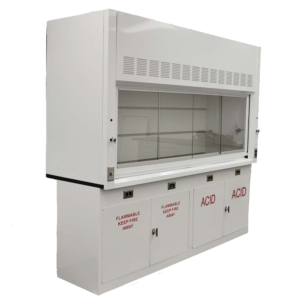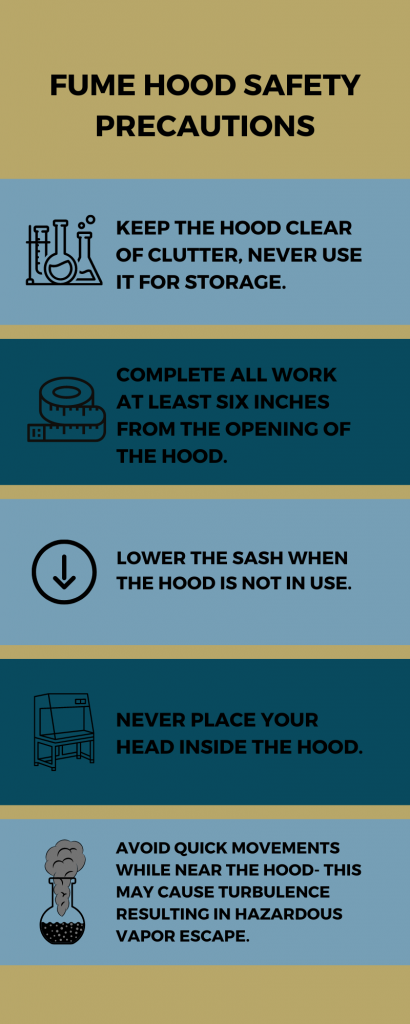
Fume hoods play a critical role in laboratory safety, acting as the first line of defense when working with toxic, flammable, or explosive materials. Alongside protective gear like safety glasses, gloves, and lab coats, a well-functioning fume hood is essential for minimizing exposure to hazardous substances.
But here’s the key: a fume hood only provides protection when it’s used correctly and maintained properly. Its primary purpose is to safeguard users from harmful fumes and materials, while a secondary function is to serve as a barrier in the event of an explosion. Both goals can only be achieved if the hood is in good condition and the sash is lowered during operation.
How Do You Make Sure That Your Fume Hood Is In Good Condition?
Operating Standards
When using a fume hood, you should always check to be sure that it has been inspected within the last 12 months. We have more details on how often to inspect your fume hood. Evaluate the hood before each use to ensure that it is operating at the correct face velocity.
It’s also imperative that you practice safety precautions while working within a fume hood.
– Keep the hood clear of clutter; never use it for storage.
– Complete all work at least six inches from the opening of the hood.
– Lower the sash when the hood is not in use.
– Never place your head inside the hood.
– Avoid quick movements while near the hood- this may cause turbulence, resulting in hazardous vapor escape.
Certification
To ensure that your fume hood continues to function properly, it must be tested upon installation and at least once a year. To obtain a certification, the fume hood must meet certain requirements.
ASHRAE (American Society of Heating, Refrigerating and Air Conditioning Engineers) has defined three methods for evaluating fume hoods:
1. As Manufactured (AM): Requires the manufacturer to test the fume hood in their facility and provide the test data with the hood.
2. As Installed (AI): The most common mode used for testing fume hoods. It is done after the unit is installed and before it is used to verify that it is operating properly and safely.
3. As Used (AU). A dynamic test was performed in an actively occupied lab. This test is usually used as a diagnostic test to assess the nature or source of a problem.
The ANSI/ASHRAE 110 test is a method of testing the performance of laboratory fume hoods. The three test procedures incorporated into the ASHRAE 110 test are the Face Velocity Grid Test, Flow Visualization or Smoke Test, and Tracer Gas Containment Test. Tracer gas containment tests are especially important, as studies have shown that face velocity is not a good predictor of fume hood leakage.
For the hood to pass, the following conditions must be met:
– The average face velocity with the sash at an opening of 18 inches must be a minimum of 100 fpm.
– The average face velocity with the sash at an opening of six inches cannot be greater than 300 fpm.
– Smoke cannot come out of the hood.
Airflow Monitors
Airflow monitors are the best way to tell if your fume hood is operating in compliance with ASHRAE 110 and other regulations. They directly measure the velocity of the air coming into a fume hood, ensuring that the hood has adequate containment and ventilation. Most fume hoods are equipped with monitors that will sound an alarm when the airflow drops to approximately 80% of the design velocity.
Although you are required to have an airflow monitor on your fume hood, not all hoods come with monitors. This is because many different types of monitors serve different purposes. There are two major types of airflow monitors; analog and digital.
Whether your fume hood operates on a constant air volume (CAV) or variable air volume (VAV) system will determine which type of monitor you can get.
If the hood is installed on a CAV system, you can use either a digital or an analog airflow monitor provided by the hood manufacturer.
If the hood is installed on a VAV system, the airflow monitor must come from the VAV supplier so that it can be properly calibrated. A CAV monitor from a hood manufacturer will not work on a VAV system because when the sash is lowered, the face velocity will increase.
As with all other equipment, it’s important to make sure that you maintain your fume hood. Your safety, and the safety of those around you, is dependent on it functioning properly.
If you find that your fume hood is faulty and needs to be replaced, please contact us at (815) 670-6400.




